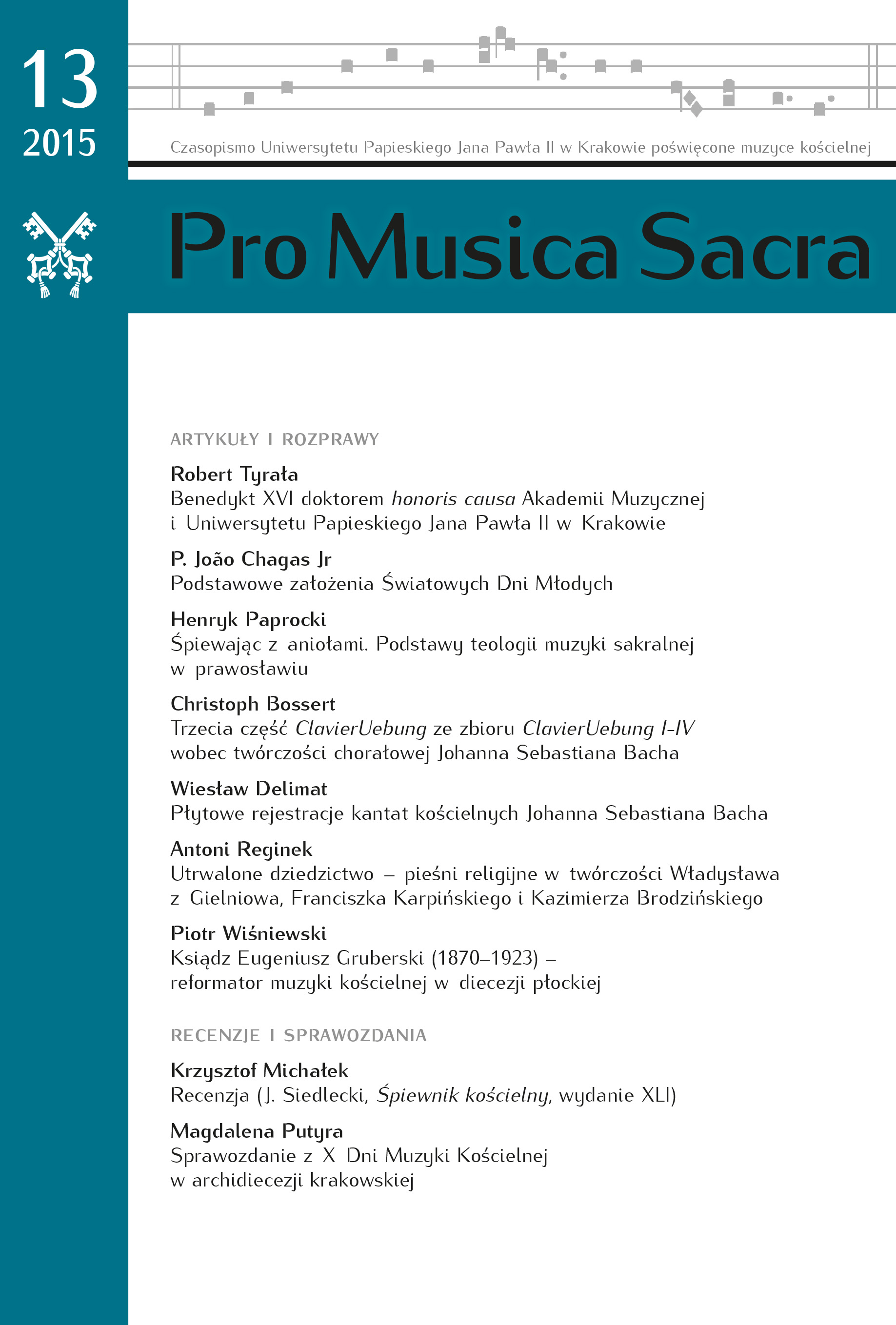Płytowe rejestracje kantat kościelnych Johanna Sebastiana Bacha
DOI:
https://doi.org/10.15633/pms.1118Słowa kluczowe:
Johann Sebastian Bach, barok, dyskografia, kantata kościelna, nagranie, płyta, wykonanieAbstrakt
Kantaty kościelne Johanna Sebastiana Bacha zajmują szczególne miejsce wśród dzieł kompozytora. Będąc muzyką użytkową, przeznaczoną do wykonania w trakcie liturgii i służącą lepszemu zrozumieniu czytań biblijnych, są jednocześnie przykładem arcydzieł prezentujących najwyższe artystyczne walory. Towarzysząc Bachowi w trakcie całego twórczego życia, stały się kantaty kalejdoskopem wszelkich stosowanych przez niego form i technik, a także wykorzystywanych motywów i środków kompozytorskich. Zapomniane po śmierci kompozytora, dzieła te zostały na nowo odkryte w XX wieku. Charakterystyka i historia wykonawstwa kantat wypełnia I rozdział pracy.
Upowszechnienie kantat Bacha związane było z wprowadzeniem ich do repertuaru koncertowego oraz z rozwojem światowej fonografii. Pierwsze pojedyncze nagrania płytowe kantat pochodzą z lat 50. XX wieku. Nieco później rozpoczęto cykliczne nagrywanie tych utworów. W związku z tym, że liczba zachowanych do dnia dzisiejszego kantat wynosi około 200, każdorazowy projekt nagraniowy cyklu wzbudza ogromne zainteresowanie słuchaczy, melomanów i krytyki muzycznej. Do chwili obecnej zarejestrowanych zostało zaledwie kilka kompletów kantat Bacha. Ze względu na wysokie walory artystyczne i poznawcze niektóre z tych nagrań zasługują na szczególną uwagę. Wszystkie one zostały szczegółowo opisane w rozdziale II.
Oprócz kompletnych nagrań kantat Bacha istnieje szereg płyt zawierających ich większy lub mniejszy wybór. Wiele z tych nagrań uznane zostało przez muzyczną krytykę za najważniejsze osiągnięcia światowej fonografii. Ich zestawieniem i porównaniem zajmuje się autor w rozdziałach II i III.
Bibliografia
Ciepliński P., Modlitwa liczb. O narodzinach nowożytności z ducha muzyki Jana Sebastiana Bacha, „Anthropos?” nr 2–3 (2004), http://www.anthropos.us.edu.pl/anthropos2/texty/cieplinski.htm [dostęp: 25.03.2015].
Dürr A., Kantaty Jana Sebastiana Bacha, Lublin 2004.
Rieger S., Przewodnik po płytach, „Tygodnik Powszechny” nr 4 (2000).
Rutkowski B., Życie muzyczne w kraju – Kraków, „Ruch Muzyczny” (1949) nr 3 (81), s. 15.
Wolff Ch., Johann Sebastian Bach. Muzyk i uczony, Warszawa 2011.
Pobrania
Opublikowane
Numer
Dział
Licencja
Autorzy publikujący w czasopiśmie udzielają jego wydawcy zgody o następującej treści:
- Autor zachowuje autorskie prawa majątkowe do utworu, a jednocześnie udziela wydawcy czasopisma zgody na jego pierwszą publikację w wersji drukowanej i wersji online na licencji Creative Commons Uznanie autorstwa 4.0 Międzynarodowe oraz zgody na wykonywanie opracowań, w tym przekładów.
- Autor ma możliwość udzielania zgody niewyłącznej na opublikowanie utworu w wersji, która ukazała się w czasopiśmie (np. zamieszczenia go w repozytorium instytucjonalnym lub opublikowania w książce), wraz z informacją o jego pierwszej publikacji w czasopiśmie.
- Autor może umieścić swój utwór online (np. w repozytorium instytucjonalnym lub na swojej stronie internetowej) jeszcze przed zgłoszeniem utworu do czasopisma.

